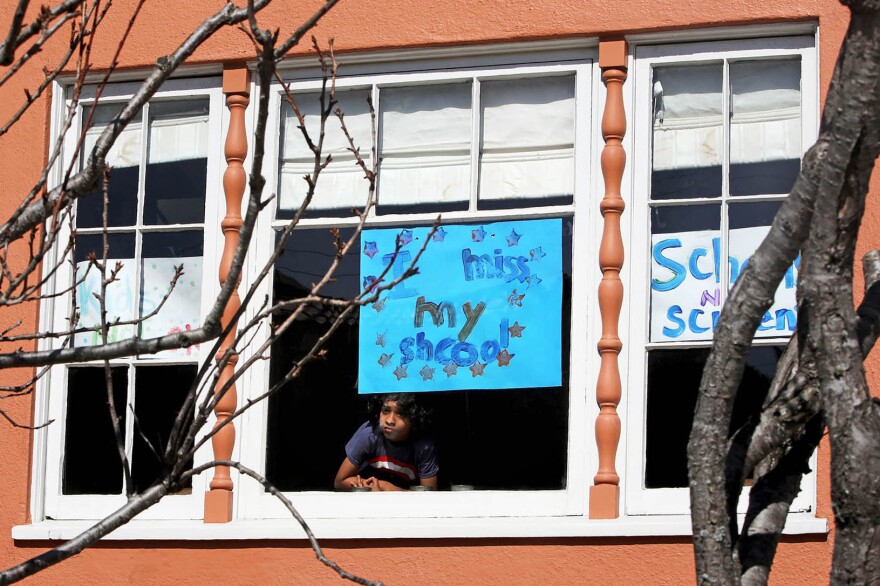Updated March 19, 2021 at 12:46 PM ET
The Centers for Disease Control and Prevention has updated its guidance for schools. On Friday, the agency announced it "now recommends that, with universal masking, students should maintain a distance of at least 3 feet in classroom settings."
Previously the guidance stated, "Physical distancing (at least 6 feet) should be maximized to the greatest extent possible." The new guidelines still call for 6 feet of distance between adults and students as well as in common areas, such as auditoriums, and when masks are off, such as while eating. And the 6-foot distancing rule still applies for the general public in settings such as grocery stores.
The change is momentous because in many places around the country, the 6-foot guidance has been interpreted as requiring schools to operate on part-time or hybrid schedules to reduce class sizes. A 3-foot rule would allow many more schools to open in person full time.
The revision was spurred by some new research, including a study published March 10 in the journal Clinical Infectious Diseases, which looked at schools in Massachusetts, where districts were given a choice of distancing students either 6 or 3 feet apart, and where the majority of districts also required universal masking. The study included more than a half-million students who attended school in person last fall.
"We didn't see any substantial difference in cases among students or staff in districts with 3 feet versus 6 feet, suggesting that we can open the schools safely at 3 feet, provided that some of the mitigation measures that were present here in Massachusetts are in place," said Westyn Branch-Elliman, a co-author of the study and an infectious diseases specialist at Beth Israel Deaconess Medical Center. "Our study adds to a growing body of worldwide data about the safety of 3 feet in school settings."
The World Health Organization already recommended that schools distance children 1 meter apart (3.3 feet). The American Academy of Pediatrics, meanwhile, has been warning that "in many school settings, 6 feet between students is not feasible without drastically limiting the number of students." As a result, the group has advised flexibility, telling school leaders to "weigh the benefits of strict adherence to a 6-feet spacing rule between students with the potential downside if remote learning is the only alternative."
Some school districts have already adopted 3-feet distancing rules, including schools in Danville, Ind. "There was not a notable increase after the move to three-feet separation," Ashton Brellenthin, communications coordinator for the Danville Community School Corp., told NPR in an email. Brellenthin said the district has been open for full-time, in-person learning with universal masking since August, and it adopted the 3-foot rule in October. She said there were cases linked to Thanksgiving, when families gathered together outside school, but "other than the two weeks following that holiday, our numbers have been consistently low."
This fits with a body of evidence that suggests schools do not drive transmission of the virus, rather they tend to mirror the spread in the community.
About 30% of U.S. students attend schools that have adopted part-time or hybrid schedules, according to the organization Burbio. These schedules can have children attending in person for as few as five days every three weeks. While at home, depending on school staffing, they may be joining in-person classes by video, or they may be completing packets of homework or online assignments without live support.
In Dallas, Superintendent Michael Hinojosa said his high schools' hybrid schedule has reduced student engagement. "They're in school Monday, Tuesday. Then nobody's there on Wednesday, then another group's there on Thursday and Friday. And so our participation level has been very low," Hinojosa said. "Hopefully, with the new CDC guidelines of 3 feet, we can get more kids in there."
Parent surveys suggest hybrid models can be the worst of both worlds. In a recent NPR/Ipsos poll of parents, those with children enrolled in hybrid learning were the most likely to feel worried that their child will be behind when the pandemic is over (62% agreed versus 50% of those attending remote, and 37% attending fully in person). They were also most likely, by a wide margin, to believe that the pandemic has disrupted their child's education.
Similarly, a new national survey of parents from the group ParentsTogether found that, compared with parents of students attending either fully remote or full time in person, "Parents of kids doing blended learning are more concerned about their kids' mental health, more concerned about them falling behind, more concerned about them not getting enough instructional support, more concerned about them getting bad grades, failing, or not finishing," ParentsTogether co-founder Justin Ruben said. For example, in the survey, 62% of respondents with students in the hybrid model said their child's mental health had gotten worse since the pandemic started, compared with about half of parents with students in the other two models.
On Friday, the CDC also released the results of a parent survey showing that, when children were in blended models, parents reported their children had less physical activity, less time outside, less time with their friends and worse mental and emotional health, compared with students attending school five days a week.
And teachers, too, report lots of stress with hybrid models. In December, Randi Weingarten, president of the American Federation of Teachers, called for the model to be phased out. "Hybrid doesn't work," she said. "You can't livestream and teach in person at the same time."
Copyright 2023 NPR. To see more, visit https://www.npr.org.









